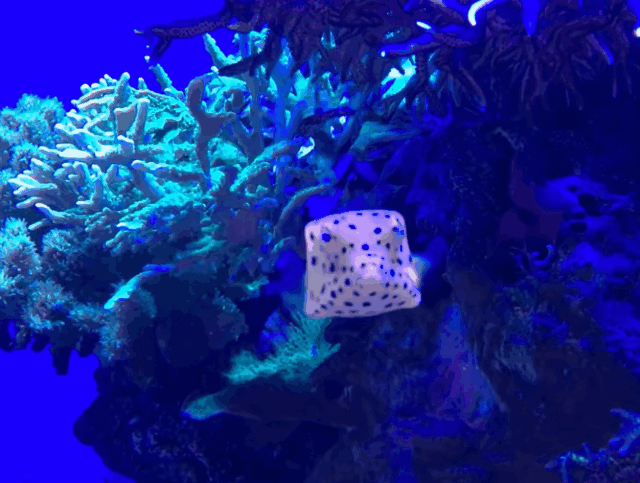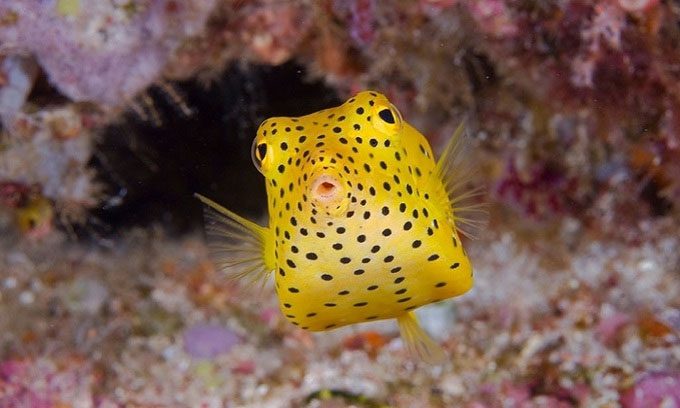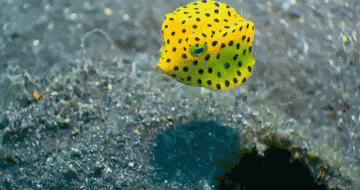Despite having a rather bulky body, the yellow boxfish swims as fast as a bullet to catch prey using its tail fin.
The brightly colored fish with black spots, resembling a square box, is scientifically named Ostracion cubicus, commonly referred to as the yellow boxfish or round-backed boxfish. They are predominantly found in the coral reefs of the Pacific Ocean, Indian Ocean, and southeastern Atlantic, primarily feeding on small prey (small worms, crustaceans, mollusks, and small fish…) and organic debris on the surface of the reefs.

The entire body of the fish looks like a box with black spots on a yellow background.
The vibrant yellow body is covered with round black spots, making the fish resemble a box decorated with these spots. Because the yellow boxfish prefers to live alone and is very shy, its bright yellow skin and black spots serve as a warning to potential predators.
When attacked or threatened, the skin of the yellow boxfish releases a characteristic neurotoxin known as Ostracitoxin. Many people have attempted to keep them as pets but have failed, as if kept in relatively enclosed spaces like aquariums, the released toxin can kill other fish in the tank.
The yellow boxfish has a rectangular body shape resembling a plastic box equipped with fins. Despite its clumsy appearance, this fish can navigate through the nooks and crannies of the coral reefs to catch shrimp. Pim Boute, a PhD researcher at Wageningen University in the Netherlands, and colleagues discovered how the yellow boxfish uses its tail fin to move in a study published on April 8 in the Royal Society Open Science.

Boxfish with a box-shaped body. (Photo: NYT).
Most fish species, from eels to sharks, have flexible bodies that allow them to move with the currents. However, the boxfish has a hard shell that forms a box-like structure around its body, serving as armor against predators but limiting its flexibility. Therefore, when they want to move, boxfish primarily rely on their fins, according to Boute.
Most fish have soft, elongated bodies that adapt to the aquatic environment, enabling them to swim freely. In contrast, the yellow boxfish has a rigid, box-shaped skeleton, which is quite different from the fish we commonly know, even leading one to wonder if there is something amiss in their evolutionary process. How can they swim with such a square-shaped body?
Interestingly, despite appearing slow, the yellow boxfish is extremely agile, arguably one of the most nimble fish in the coral reef area.

If you look closely, you can see its tail firmly attached to the body.
Based on previous studies and underwater observations, Boute hypothesized that the tail fin is a crucial factor in creating lateral movement. To test this hypothesis, Boute and colleagues used a 3D plastic model of the boxfish without a tail. They placed the model in a tank, secured it in place with thin rods, and pumped water through as if the real fish were swimming while a sensor measured the torque of the model.
The research team repeated this process multiple times, changing the angle of the model relative to the water current each time. They then conducted a similar experiment with the model attached to a tail fin. They tested the fin in various positions such as spread out, extended straight, or angled left or right.
The researchers found that without a tail fin, the boxfish relied on the flow of water to propel itself. However, the wide-spread tail fin provided stability regardless of the model’s angle relative to the water flow. Meanwhile, the closed tail allowed the fish to cope with the impact of incoming water from various angles. This indicates that by spreading, closing, or bending its tail, the boxfish can control its body movements at will.




















































